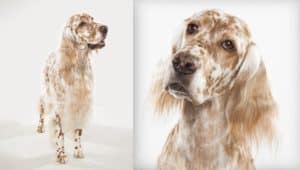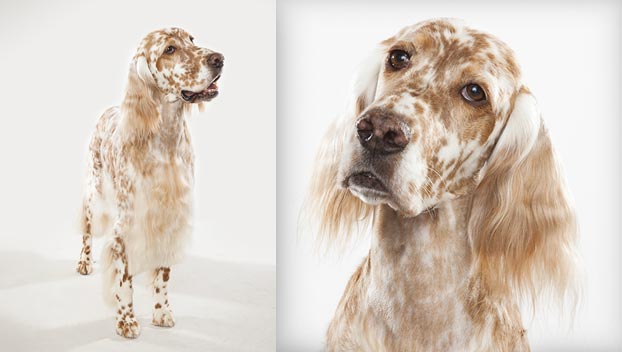 The coat of an English Setter is trimmed in parts to accentuate the dog’s elegance and glamor. The art of grooming an English Setter is to make a clean and tidy outline, while maintaining a natural appearance. Thinning scissors should only be used for cutting up and into the lie of coat.
The coat of an English Setter is trimmed in parts to accentuate the dog’s elegance and glamor. The art of grooming an English Setter is to make a clean and tidy outline, while maintaining a natural appearance. Thinning scissors should only be used for cutting up and into the lie of coat.
This will mean that it is only the undercoat that is removed, allowing the topcoat to lie flat. Scissors are not used on the back or sides of the dog as, ultimately, the coat will be ruined – often permanently.Clippers should not be used on the body, as this will ruin the gentle, flowing look of the coat. Some English Setters do have a thick and unruly coat, and the temptation is to clip this off.
However, consultation with the owner is essential before performing this procedure.
The coat is basically white, either lightly or heavily flecked with blue or orange (known as “belton”). The blue or orange can be of different shadings. Occasionally, lemon or liver beltons are seen. Blue beltons with tan around the muzzle and feet are known as tricolor.
The coat from the back of the head, in line with the ears, is slightly wavy (not curly) and, like the rest of the coat generally, is long and silky. The breeches and forelegs nearly down to the feet are well feathered.
Grooming Procedure
Equipment needed: Slicker brush and fine-toothed comb.
It is advisable only to cut once or twice with the thinning scissors before brushing out the loose hair. This way, you can check if sufficient hair has been removed and will not accidentally over-trim.
Novice pet owners who decide to show their English Setters would be well advised to seek the advice of an experienced show exhibitor.
- Brush through, being careful to remove any tangles. Use untangle cream if necessary.
- Next, turn your attention to the head. The soft, tufty down that grows on the head is best removed by gently plucking with the thumb and finger, taking a little at a time.
- The neck: the hair under the neck grows in an upside-down fan shape (down to the breastbone, curving out towards the shoulder and ears). With the thinning scissors, clean out this fan-shaped area until the hair on both sides of the neck blends in with the longer hair on the shoulders.
- The ears: with the thinning scissors, cutting upwards into the long hair, repeat the cutting action until all the hair is short and lies flat. Leave the hair on the front edge of the ear longer, giving the desired soft expression. Remove the hair from under the ears so that the ears lie close to the neck.
- The tail: with the thinning scissors, remove the hair from under the base of the tail to about 1 inch (2.5 cm). Brush the tail feathers well. Then, holding the feathers firmly against the tail, measure against the top of the English Setter’s hock. The tail should stop at this level or slightly above. With the ordinary scissors, remove all the excess hair that falls past the end of the tail, or, if the fleshy part of the tail is short, cut a little further down. Once you let the tail-feathering loose, it will then fall in a scimitar shape.
- The back of the pastern: using the thinning scissors, trim off all the excess hair that can be found growing down the back of the hock to the foot.
- The feet: with a pair of ordinary scissors, trim off the hair around the pads. Then, with the thinning scissors, trim the excess hair from between the toes. To do this, view the foot from the top. With your thumb, pull up all the excess hair from between the toes, cutting upwards from the nail toward the leg, using several cutting motions until all the protruding hair is removed. This method is applied to both front and back feet.
- Bathe the English Setter in a suitable shampoo.
- Rinse thoroughly and then apply conditioner.
- Towel-dry the dog, then blow-dry along the growth of the hair. Alternatively, cage-dry after combing through the entire coat.
- Check the Setter’s nails, ears and teeth.

